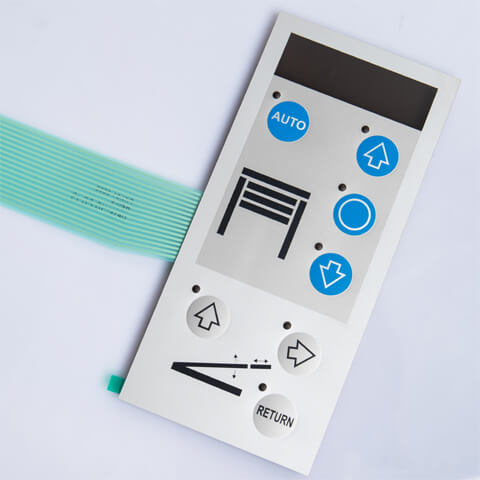The Function of a Membrane Switch in Modern Touch Interfaces and Controls
Wiki Article
Understanding the Performance of Membrane Layer Switches Over for User Interface Instruments
The functionality of membrane layer switches over represents a significant innovation in individual interface design, combining efficiency with visual convenience. As markets increasingly focus on individual experience, recognizing the nuances of membrane switch innovation comes to be vital.What Are Membrane Layer Buttons?
Membrane layer switches are ingenious interface tools that assist in customer communication with electronic devices. These versatile components are composed of several layers, consisting of a visuals overlay, spacer, and a printed circuit layer. The design permits a smooth integration right into various electronic devices, boosting both the visual and functional aspects of interface.
Membrane buttons are commonly used in a variety of applications, from house home appliances to industrial machinery and medical devices. Their construction normally features a thin profile, making them an optimal choice for portable layouts. The responsive comments provided by these buttons can be crafted to fulfill certain individual choices, making certain reliable communication in between the customer and the device.
Sturdiness is an additional significant advantage of membrane layer buttons, as they are immune to dust, wetness, and chemicals, which enhances their life expectancy in demanding atmospheres. In addition, these buttons can be tailored in regards to shape, dimension, and visuals style, enabling for branding and user-specific functions. In general, membrane layer changes stand for a practical solution for improving individual experience in electronic tools, incorporating performance with visual appeal in an effective manner.
How Membrane Switches Job
Operating on a straightforward concept, membrane switches utilize a layered building and construction to register user input properly. Each switch is composed of multiple layers, including a printed circuit layer, a spacer layer, and a leading graphic layer, which are made to function together flawlessly. When a user presses the top layer, it compresses the spacer layer, bringing the conductive aspects of the circuit layer into call with each various other.This contact develops a shut circuit, indicating the gadget to execute a specific function. The style permits for different arrangements, consisting of tactile responses, which can boost the customer experience by giving a physical feeling upon activation. The products utilized in membrane buttons frequently include versatile substratums, such as polyester or polycarbonate, which ensure longevity and resilience versus deterioration.

Trick Advantages of Membrane Layer Buttons

An additional substantial benefit is their compactness. Membrane layer buttons are thin and light-weight, which enables suppliers to conserve area in their gadgets without giving up functionality. This attribute is specifically useful in applications where weight and volume are vital considerations.
Furthermore, membrane layer switches are resistant to dust, dampness, and chemicals, improving their toughness. This durability prolongs their life-span and reduces the demand for constant substitutes, leading to see this price financial savings in time.
Moreover, the responsive comments supplied by membrane layer switches can be maximized to improve customer interaction. They can consist of features such as increased switches or audible clicks, enhancing use and individual experience.
Applications Across Industries
Customer user interface gadgets making use of membrane layer switches prevail in a vast range of markets, showcasing their versatility and capability. Membrane Switch. In the medical industry, membrane layer buttons are integral to devices such as analysis equipment and patient monitoring systems, where their toughness and ease of cleaning are crucial for preserving hygiene standards. In the vehicle industry, these buttons are employed in control panel controls and infotainment systems, offering a streamlined and contemporary interface for customers.In addition, the customer electronic devices industry gain from membrane buttons in devices and portable gadgets, where small design and easy to use user interfaces enhance customer experience. Industrial applications also utilize membrane changes for control board in equipment and automation systems, emphasizing their robustness and resistance to harsh environments.
In the aerospace and protection markets, membrane switches are made use of in cabin controls and equipment, where integrity and performance under extreme problems are vital. In addition, the video gaming industry significantly incorporates membrane switches in controllers and gallery makers, adding to an interesting user experience. On the whole, the convenience of membrane switches enables their prevalent use throughout many markets, emphasizing their significance in modern-day interface style.
Future Trends in Membrane Change Technology

In addition, making use of sophisticated materials, such as polycarbonate and polyester films, is expected to rise, supplying boosted toughness and resistance to ecological stress factors. These products add to the overall durability of membrane layer buttons, making them suitable for harsher commercial applications.
Moreover, the incorporation of smart innovation, including IoT connectivity, will make it possible for click here to find out more membrane buttons to interact with other tools and systems, helping with an extra interactive individual experience. This trend aligns with the expanding demand for wise tools across different industries, from healthcare to consumer electronic devices.
Lastly, modification options are prepared for to expand, enabling suppliers to develop bespoke options tailored to particular user demands and preferences. These advancements will place membrane buttons as crucial components in the evolution of user interface technology.
Verdict
In final thought, membrane layer changes stand see for an essential improvement in user interface technology, offering a reliable and versatile remedy for varied electronic applications. As advancements in material scientific research and touch picking up technologies continue, the capability and applicability of membrane layer switches are expected to increase, strengthening their importance in modern-day digital devices.
Report this wiki page